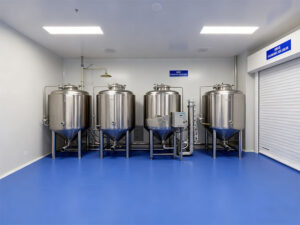Selecting the right primer for acrylic polyurethane paint is crucial for achieving optimal performance. A well-matched primer not only reduces the risk of coating defects but also enhances the corrosion resistance of the acrylic polyurethane paint. The method of choosing the primer is even more important than the product itself!
Epoxy zinc-rich primer is the preferred choice for heavy-duty corrosion protection on steel substrates and is one of the most effective ways to improve the corrosion resistance of acrylic polyurethane paint. Different zinc contents result in varying levels of anti-corrosion performance.
If acrylic polyurethane paint is paired with a single-component primer or alkyd primer, issues like peeling and cracking may occur. However, when paired with a compatible primer, it significantly enhances corrosion resistance while also improving the aesthetic appeal of steel structures.
On the other hand, an incompatible primer can be counterproductive, failing to provide adequate protection or corrosion resistance. Therefore, selecting a primer that complements and enhances the performance of acrylic polyurethane paint has become a primary consideration for many companies in corrosion protection.
How to Select the Perfect Primer for Acrylic Polyurethane Paint
As a high-performance coating, acrylic polyurethane finish demonstrates exceptional properties in anti-corrosion applications. The selection of a compatible coating system is critical to ensuring overall performance. Below are three recommended coating systems for acrylic polyurethane paint, tailored to different application scenarios, to provide professional guidance.
Option 1: Anti-Corrosion Coating for Harsh Environments
Epoxy Zinc-Rich Primer + Epoxy Mica Iron Oxide Intermediate Coat + Acrylic Polyurethane Finish
This system is specifically designed for steel structures exposed to extreme or complex corrosive environments. The epoxy zinc-rich primer provides excellent cathodic protection and strong adhesion, forming a solid foundation for the coating system. The epoxy mica iron oxide intermediate coat further enhances corrosion resistance with its superior barrier properties and intercoat adhesion. Finally, the acrylic polyurethane finish delivers outstanding weather resistance, chemical resistance, and gloss, ensuring long-lasting protection and aesthetics. This system is ideal for critical infrastructure such as outdoor large-scale facilities and bridge steel structures.
Option 2: Efficient Corrosion Protection for General Steel Structures
Epoxy Primer + Epoxy Mica Iron Oxide Intermediate Coat + Acrylic Polyurethane Finish
This system is suitable for general steel structures like industrial machinery and factory buildings. The epoxy primer provides initial corrosion protection and adhesion, the epoxy mica iron oxide intermediate coat strengthens the anti-corrosion barrier, and the acrylic polyurethane finish ensures durability and an attractive finish. This combination balances performance and cost-effectiveness, making it an ideal choice for most industrial applications.
Option 3: Corrosion Protection and Aesthetic Enhancement for Concrete Substrates
Epoxy Sealer + Epoxy Intermediate Coat + Acrylic Polyurethane Finish
For concrete substrates, this system begins with an epoxy sealer to fill surface pores, preventing moisture and salt penetration. The epoxy intermediate coat further improves impermeability and adhesion, while the acrylic polyurethane finish provides excellent weather resistance, chemical resistance, and a visually appealing finish. This system is widely used for concrete floors, walls, and other structures requiring both protection and decoration.
Compatibility Warnings for Acrylic Polyurethane Paint
- Avoid single-component primers. Since acrylic polyurethane paint is a two-component topcoat, single-component primers have poor solvent resistance and may dissolve when the topcoat is applied.
- Use compatible thinners. Always use the recommended thinner for acrylic polyurethane paint to avoid compromising quality.
- Choose slow-evaporating thinners. Fast-drying thinners may prevent proper adhesion to the substrate.
- Two-component mixing. Acrylic polyurethane paint is a two-component system—mix only the required amount, and use it within 4 hours to avoid waste.
- Drying time for epoxy zinc-rich primer. While epoxy zinc-rich primer adheres well to steel, it is chemically different from acrylic polyurethane paint. Ensure the primer is fully cured before applying the topcoat to prevent “lifting.”
- Do not interchange thinners. Using the wrong thinner may cause resin separation or improper dissolution.
Conclusion: Whether acrylic polyurethane paint requires a primer and what type of primer to use depends on factors such as the application environment, anti-aging requirements, corrosion protection lifespan, and weather resistance needs. A professional coating system ensures professional results.







